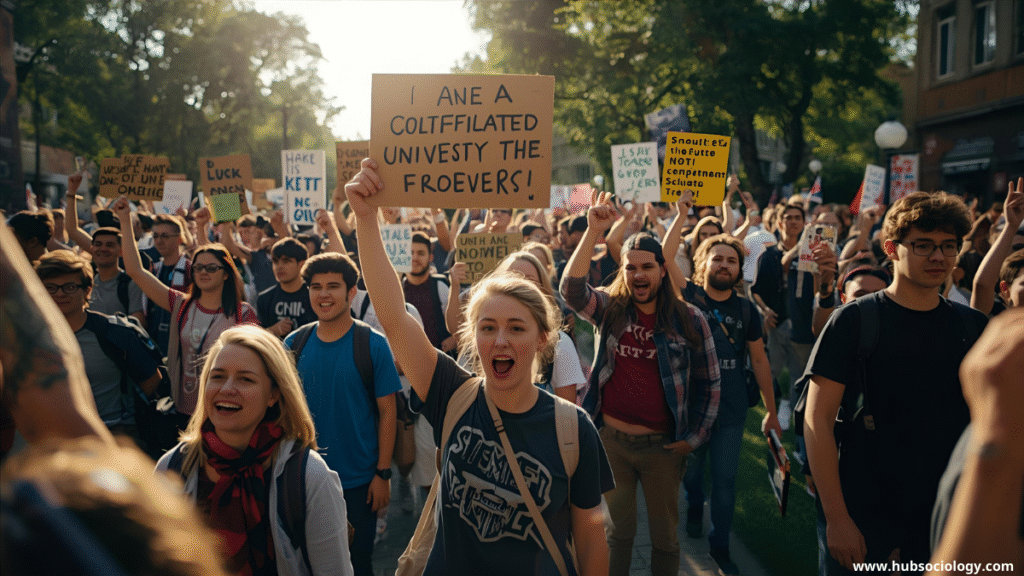Introduction on Inequality and Social Stratification
Societies across history have been marked by differences in wealth, power, and status. These differences are not accidental; rather, they are structured and maintained through various social mechanisms. Sociology uses the concept of social stratification to explain these divisions, and it views inequality as a central outcome of stratified social systems. While inequality can be based on natural differences in talent and ability, in most cases it is socially constructed and reinforced by institutions such as the economy, politics, education, and culture. Understanding the sociological dimensions of inequality and stratification is therefore crucial for analyzing how societies function and evolve.

Table of Contents Inequality and Social Stratification
The Concept of Social Stratification
In society, the hierarchical arrangement of people and groups is referred to as social stratification. It entails assigning a ranking to individuals according to their access to resources including opportunities, wealth, power, and status. Unlike temporary differences, stratification is systematic and enduring. It exists in all societies, whether simple tribal communities or complex industrial nations, though the criteria of stratification may vary.
Sociologists identify four primary systems of stratification:
- Slavery – Where individuals are treated as property and denied freedom.
- Caste – A hereditary system, as in traditional India, where mobility is nearly impossible.
- Estate – A medieval European system dividing society into nobles, clergy, and peasants.
- Class – The modern system, based on economic positions and opportunities, which allows some social mobility.
Although class is the dominant form today, caste-like and estate-like structures still persist in many societies.
Inequality as a Product of Stratification
Inequality, or the unequal distribution of resources and opportunities in life, is a result of social stratification. It affects not only income and wealth but also education, healthcare, housing, and political power. Inequality is multidimensional and can be observed in several forms:
- Economic Inequality: Differences in income and property ownership.
- Political Inequality: Unequal influence over decision-making and governance.
- Social Inequality: Unequal prestige, status, and respect.
- Cultural Inequality: Differences in recognition of values, traditions, and identities.
Stratification legitimizes inequality by embedding it into social norms and institutions. For example, education systems may reward middle-class cultural values, leaving working-class students at a disadvantage.
Theoretical Perspectives on Stratification and Inequality
Sociologists have developed various theoretical frameworks to explain why stratification exists and how it persists.
1. Functionalist Perspective
According to functionalists like Wilbert Moore and Kingsley Davis, stratification is necessary for social stability. They argue that certain roles, such as doctors, engineers, or leaders, require greater skills and responsibility. To motivate individuals to perform these roles, society must reward them with higher prestige and income. Therefore, the purpose of stratification is to assign the most qualified individuals to the most crucial positions.
Critics, however, argue that this perspective justifies inequality and ignores the fact that opportunities are not equally distributed. For example, a poor but talented student may never get the chance to become a doctor due to lack of resources.
2. Conflict Perspective
Drawing from Karl Marx, the conflict theory views stratification as a tool of exploitation. The bourgeoisie (owners of production) dominate the proletariat (workers) by controlling economic resources and political power. Inequality benefits the ruling class while oppressing the majority. Stratification is not functional but rather a reflection of class struggle.

Neo-Marxists further argue that inequality today is reproduced through ideology, media, and education, which legitimize the interests of the elite.
3. Weberian Perspective
Max Weber added a multifaceted perspective on stratification to Marx’s critique. He proposed that inequality is shaped by power, status, and class. For example, a priest may have little wealth but high prestige, while a wealthy businessperson may lack cultural status. This approach highlights the complexity of stratification in modern societies.
4. Symbolic Interactionist Perspective
This micro-level perspective examines how everyday interactions reinforce inequality. People use symbols such as language, dress, and lifestyle to signal their social position. These daily practices reproduce class distinctions, often unconsciously. For instance, accents or tastes in food can mark someone as belonging to a certain social class.
Dimensions of Inequality in Contemporary Societies
Stratification and inequality manifest in multiple dimensions:
- Economic Stratification: The gap between the rich and the poor is growing on a worldwide scale. The top 1% of the population controls more wealth than the bottom half of humanity. A cycle of disadvantage is created by economic inequality, which affects access to housing, healthcare, and education.
- Gender Stratification: Women often face unequal pay, limited leadership opportunities, and disproportionate domestic responsibilities. Despite progress, patriarchal structures continue to shape opportunities and life chances for women worldwide.
- Racial and Ethnic Inequality: In many societies, racial and ethnic minorities face discrimination in employment, education, and political participation. Structural racism perpetuates disadvantages across generations.
- Caste and Religious Stratification: In South Asia, caste continues to determine occupational roles and marriage choices. Religious stratification also influences power and privilege in many societies.
- Global Stratification: Inequality is not limited to national boundaries. The world system reflects stratification between developed, developing, and underdeveloped nations. Peripheral countries continue to be dependent on core countries, which control global trade, technology, and finance.
Mechanisms of Reproduction of Inequality
Inequality is reproduced through various mechanisms:
- Education: Schools often favor children from privileged backgrounds through curriculum and cultural expectations.
- Family: Wealth and property are inherited, giving certain groups a head start.
- Media and Culture: Popular culture often portrays the lifestyles of the rich as desirable, normalizing inequality.
- State Policies: Laws and taxation can either reduce inequality (through welfare) or increase it (through regressive systems).
These mechanisms ensure that stratification remains stable across generations.
Consequences of Inequality
The effects of ongoing inequality on people and society are extensive:
- Social Exclusion: Marginalized groups are denied full participation in society.
- Health Disparities: Poorer populations face worse health outcomes due to lack of access to care.
- Crime and Conflict: Inequality fuels frustration, leading to crime, protests, and even revolutions.
- Erosion of Democracy: When wealth translates into political influence, democratic values are undermined.
- Reduced Social Cohesion: Extreme inequality weakens solidarity and creates mistrust among groups.
Pathways to Address Inequality and Social Stratification
Sociologists argue that inequality can be reduced but not entirely eliminated. Strategies include:
- Redistributive Policies: Progressive taxation and welfare schemes to support disadvantaged groups.
- Educational Reforms: Ensuring access to quality education for all social groups.
- Affirmative Action: Programs that provide opportunities to historically marginalized communities.
- Global Cooperation: Addressing inequalities between nations through fair trade, debt relief, and climate justice.
- Cultural Change: Challenging stereotypes, prejudices, and discriminatory norms.
Conclusion on Inequality and Social Stratification
Inequality and social stratification are universal features of human societies, but their forms and intensity vary across time and place. While stratification organizes social life, it also generates profound inequalities that affect every aspect of existence, from economic well-being to cultural recognition. Functionalists emphasize its necessity, while conflict theorists highlight its exploitative character. Weber’s multidimensional perspective and symbolic interactionist insights further reveal its complexity.

From caste in India to class divisions in capitalist economies, and from gender disparities to global inequalities, stratification continues to shape our world. Addressing inequality requires not only policy changes but also cultural transformation and collective action. Sociology reminds us that inequality is not a natural inevitability—it is a social construct that can be challenged and transformed through human agency.
Do you like this this Article ? You Can follow as on :-
Facebook – https://www.facebook.com/hubsociology
Whatsapp Channel – https://whatsapp.com/channel/0029Vb6D8vGKWEKpJpu5QP0O
Gmail – hubsociology@gmail.com
Topic related question on Inequality and Social Stratification
5 Marks Questions on Inequality and Social Stratification (Short Answer)
- Define social stratification.
- Distinguish between caste and class.
- What is meant by social inequality?
- State two consequences of inequality in society.
- Mention any two mechanisms through which inequality is reproduced.
- Differentiate between ascribed status and achieved status.
- Give two examples of global inequality.
- What is meant by cultural inequality?
10 Marks Questions on Inequality and Social Stratification (Medium Answer)
- Explain the functionalist perspective on social stratification with examples.
- Discuss Weber’s multidimensional view of stratification.
- How does education contribute to the reproduction of social inequality?
- Describe different forms of inequality (economic, political, social, cultural).
- Explain the difference between open and closed systems of stratification.
- Discuss the role of gender in social stratification with suitable examples.
- Examine the impact of racial and ethnic inequality in contemporary societies.
15 Marks Questions on Inequality and Social Stratification (Long Answer / Essay Type)
- Critically examine Marx’s conflict perspective on inequality and stratification.
- Discuss the major systems of stratification (slavery, caste, estate, class) with sociological examples.
- Analyze the consequences of social inequality for democracy and social cohesion.
- How does global stratification shape relations between developed and developing nations?
- Examine mechanisms through which inequality is legitimized and maintained in modern societies.
- Evaluate different sociological perspectives (Functionalist, Conflict, Weberian, Symbolic Interactionist) on stratification.
- Suggest measures to reduce inequality in contemporary society and discuss their sociological significance.

4 thoughts on “Inequality and Social Stratification: A Sociological Perspective”